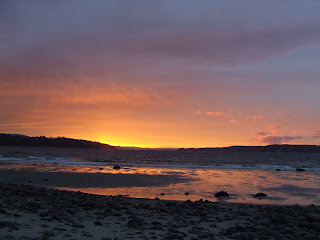The Gran Sueño Hotel in San Pedro La Laguna, eight o'clock in the morning.
I'm barely awake after a night that was finally neither too hot nor too cold – and quiet, too! There is not a whole lot of traffic here, especially this early in the morning.
Now, the relative silence is broken by music: clear voices sing what sounds like a hymn, in parts, but without accompaniment. How strange this seems on a Monday morning, loud enough for the whole town to hear! It must be coming from the Pentecostal Church a bit up the hill. Yesterday afternoon, when we went for a walk to get our bearings in our new surroundings after we arrived from Antigua, we heard Christmas carols from the same direction.
It should not really surprise me to hear hymns on a working day: Guatemalans are very religious people. This is evident not only in the many churches, but also in many ways in everyday life. Quotes from the bible are written on bill boards and house walls, and the tuk tuks – little three wheeled vehicles that serve as taxis in many towns and cities – have inscriptions like 'Jesu Christo', or 'Jehova es mi pastor' written across their windshields.
 |
| Tuk tuks, as here in Flores, are an important mode of transportation for locals and tourists |
A shuttle picked us up at our hotel, the Casa Luna in Antigua yesterday morning around eight, and dropped us off here in San Pedro on Lake Atitlan in the highlands of Guatemala about five hours later.
While we travelled on a very good highway for much of the way things changed dramatically for the last thirty kilometres, which took about an hour although it was all downhill. It was hair raising, nerve wracking, and sometimes downright scary - but it was awesome!
Once we had turned off the highway we started the steep descent to San Pedro. We needed to get down to the lake, at 1500 m altitude, from 2200 m up top.
The road, still paved, but very narrow, was worse than the ripio we had encountered on the Rta. 40 in Argentina, with huge, sometimes quite deep holes. A few times the damage from the landslides earlier this summer was still visible, too; the road had been washed out and was only marginally repaired. The driver, whose skills I greatly admire, manoeuvred his vehicle around the holes, not an easy task when there could be oncoming traffic. Even worse were the tight, tight curves that hardly had enough room to turn, sometimes very close to the precipice. He honked his horn when a curve was particularly difficult to oversee, and a few times I gasped when we managed just in time to slip back into our lane when an oncoming vehicle appeared suddenly. To our right was the mountain, to our left the very steep grade.
The road, still paved, but very narrow, was worse than the ripio we had encountered on the Rta. 40 in Argentina, with huge, sometimes quite deep holes. A few times the damage from the landslides earlier this summer was still visible, too; the road had been washed out and was only marginally repaired. The driver, whose skills I greatly admire, manoeuvred his vehicle around the holes, not an easy task when there could be oncoming traffic. Even worse were the tight, tight curves that hardly had enough room to turn, sometimes very close to the precipice. He honked his horn when a curve was particularly difficult to oversee, and a few times I gasped when we managed just in time to slip back into our lane when an oncoming vehicle appeared suddenly. To our right was the mountain, to our left the very steep grade.
During all this, however, we had a beautiful view of the lake and some of the volcanoes that ring it. Coffee plants with still green clusters of berries were growing on the steep hills, dusty like the many flowers. Tuk tuks were just as much part of the traffic as pedestrians, men, women and children carrying things up and down the hill, most notably firewood in big stacks. They were bent low under the heavy loads. The women often carry loads on their heads, but for carrying firewood they, like the men, wear a sling around their forehead that holds the load on their backs. They are so small, the Mayan people! Rarely there is a man as tall as I am, and women often don't reach much higher than my chest. Here, as in Antigua, many still wear their traditional dress, colourful skirts and blouses they have woven themselves, with an apron over top. I've heard many of them lead conversations in Maya languages. Twenty-one of them are spoken in Guatemala.
I was quite relieved when we had finally arrived at the bottom, in the little town of San Juan. Not much longer, and the shuttle stopped at the Gran Sueño hotel in San Pedro, a nice, clean place not far from the lake and downtown. Here, we'll stay until Wednesday at least, possibly until we return to Antigua on Saturday, unless we decide to move on to one of the other lake communities for the second half of the week.















